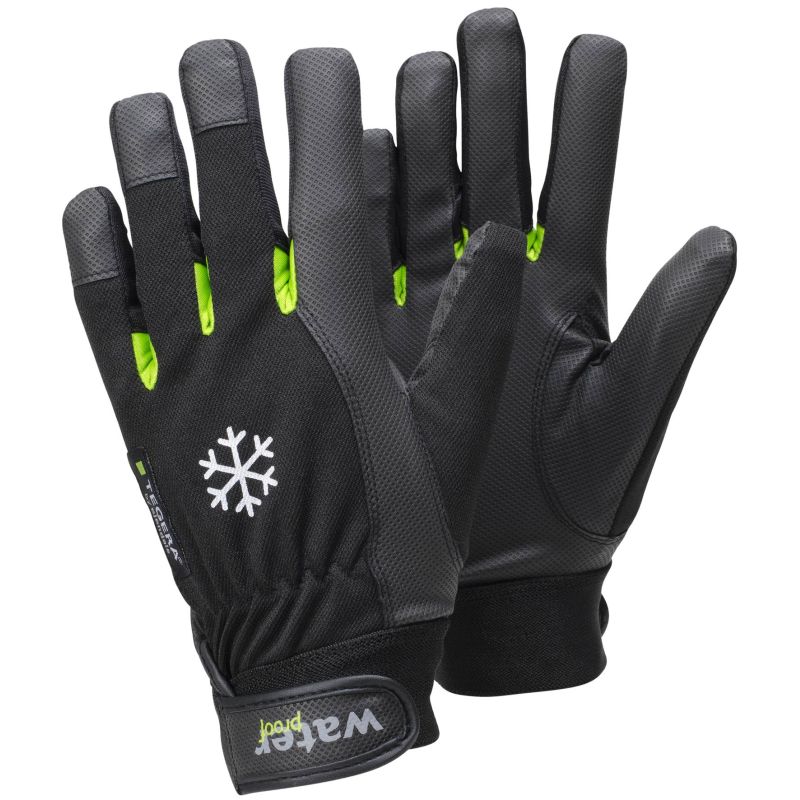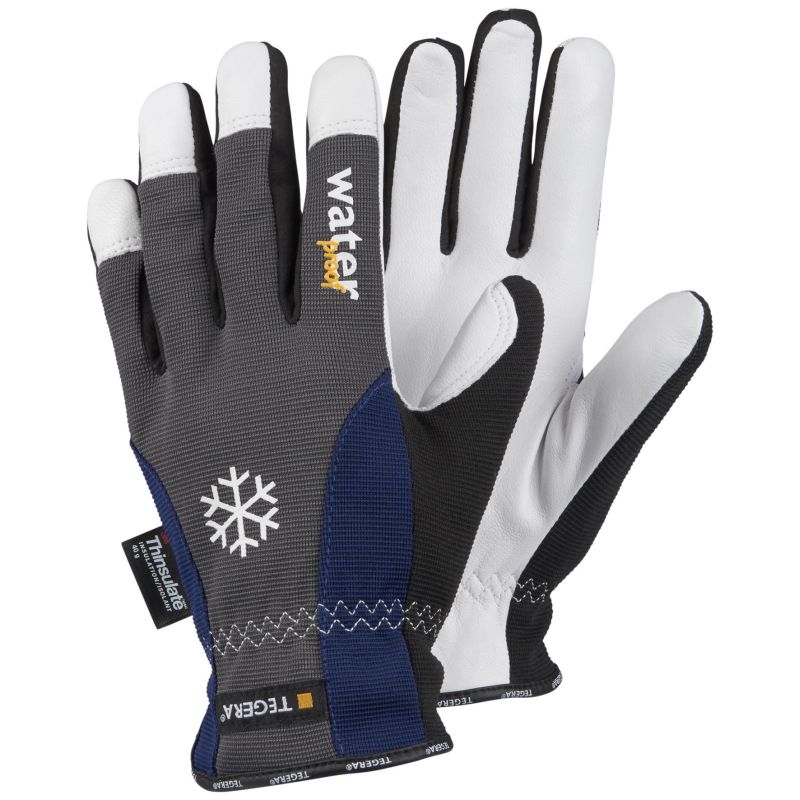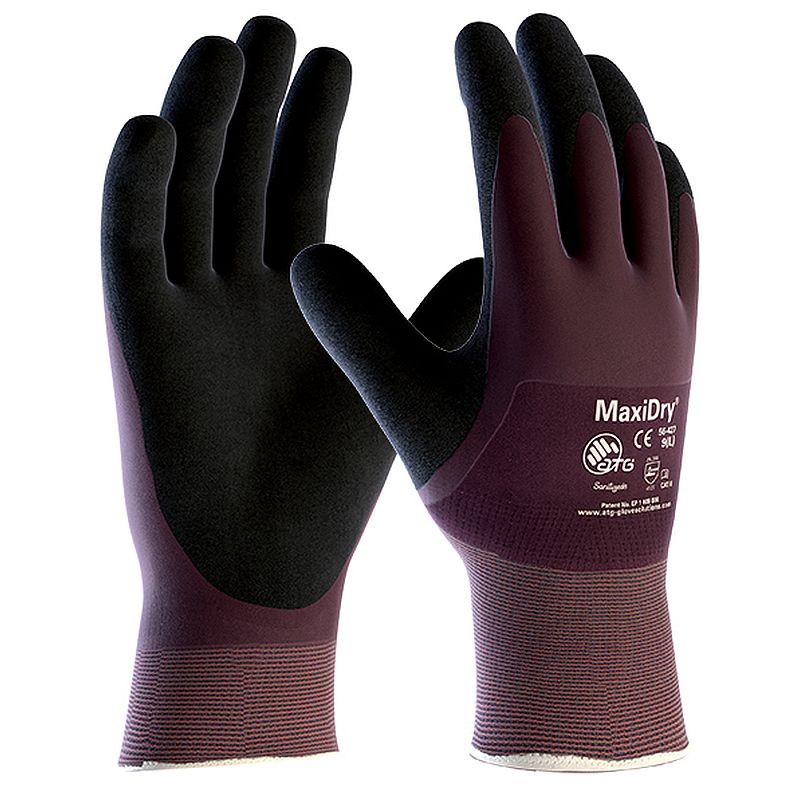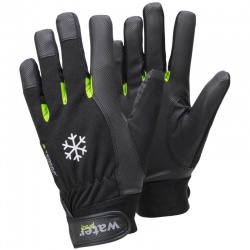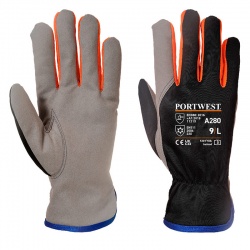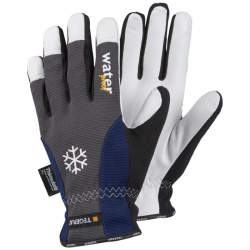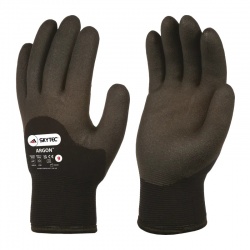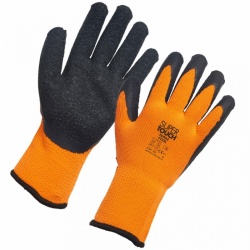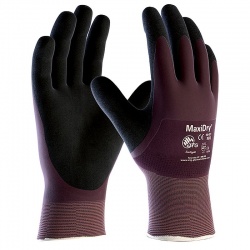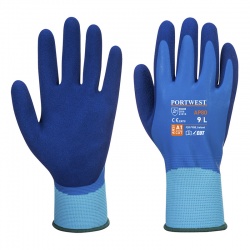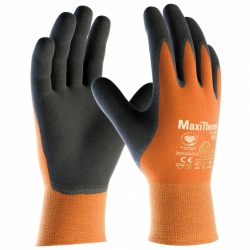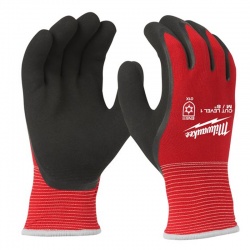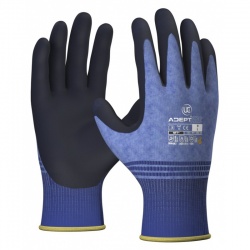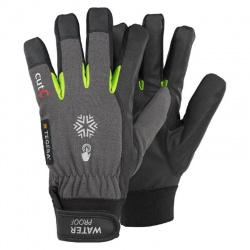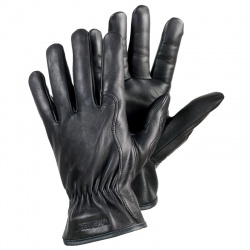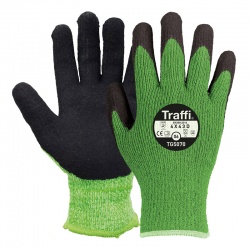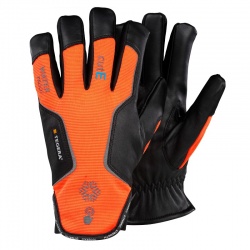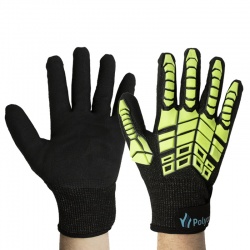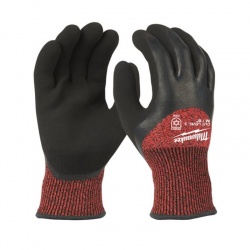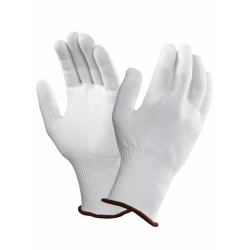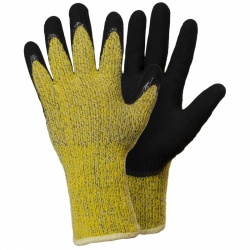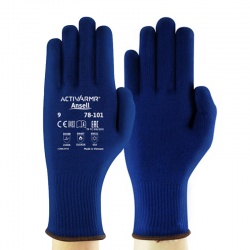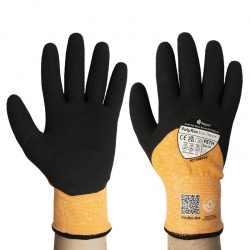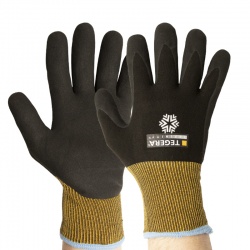EN 511 Explained
9 December 2022
EN 511 is the European standard regulating the manufacture and sale of thermal, cold-weather and water-resistant safety gloves. Whether you're here because you're fed up of numbness, loss of sensation and tingling when working outdoors with your hands, or you're unsure what markings and ratings you need when outfitting your workforce, you're in the right place.
We've put this guide together to help break down this tricky standard into simple terms. This includes a detailed look at what each rating means, what the best gloves for you are, and how you can navigate our site to find the right pair for you and your workplace.
What Does Our Guide Cover?
Make the most of your time by using our simple navigation menu. Click any of the links below to jump right in and find exactly what you're looking for.
Information Centre
What Is EN 511?
EN 511 is the European Standard that makes sure thermal and cold-resistant safety gloves are safe and doing what they say they do. Glove testing is vital because it gives the user a guarantee about the amount and level of protection they're getting before making a purchase.
Testing under EN 511 is broken down into three parts which are detailed below.
- Convective Cold: How good are gloves at shielding against cold air?
- Contact Cold: Can I use my gloves for handling sub-zero material?
- Water Permeability: How do I know if a certain pair of gloves are waterproof?
Identifying EN 511 Markings
You can identify if a glove has been tested to EN 511 through three different methods. These are:
On the Back Of Your Gloves
The first place to look is on the back of your gloves or on the glove label. You will be able to identify EN 511 either by the logo below or by the information as shown in the below image.
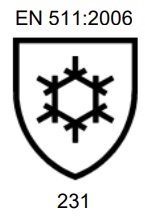 | 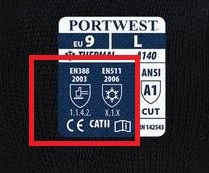 |
| The EN 511 Symbol | The Back of EN 511 Gloves |
In the Product Listing
The second place to find EN 511, is in the product listing. For example, if you take a look at the Portwest A143 Gloves and scroll down, you'll see a table identifying EN 511. The table will usually look something like the one below.
| Property | Resistance Level |
| Convective Cold Resistance | N/A |
| Contact Cold Resistance | Level 1 |
| Water Permeability | N/A |
In the Conformity Statement
The final place is in the conformity statement. A conformity statement can be found at the bottom of every single listing and will be supplied with your purchase. This statement is signed by a regulatory body, ensuring that your glove is certified to EN 511.
What Do EN 511 Ratings Mean?
Before we go into detail, let's outline exactly what you're looking at.
The results of the three available tests can be found in the table on each product listing on our site, on the back of your gloves or in the conformity statement supplied with each purchase. A glove will receive a rating as shown below, with the higher score meaning that it offers better resistance, and a lower score meaning that the gloves offer less protection.
| Resistance Test | Rating |
| Convective Cold | Level 0 - 4 |
| Contact Cold | Level 0 - 4 |
| Water Penetration Test | Level 0 or 1 |
Quick EN 511 Facts
- Level 0 means that the glove has failed the test
- "N/A" means the glove wasn't tested to that standard
- A glove can only achieve pass or a fail in the water penetration test, with "0" being a fail and "1" a pass
How Do Gloves Pass EN 511?
In order to find out which gloves suit your application, you must first understand what is involved in each of the three tests underneath EN 511. Take a look below for a break down of each of the three tests.
If you're looking for a really detailed breakdown, click here for more information.
The Convective Cold Test
How Is the Test Conducted?
This ten minute test involves the glove being placed on an electrically heated mannequin hand that measures the amount of power required to maintain a temperature between 30°C and 35°C in a controlled environmental chamber.
The chamber is cooled down to 20°C below that of the heated hand and constant air flow is applied. The assessment awards a performance level based on the amount of electrical power required to maintain this constant temperature.
| Performance Level | Thermal Insulation (TR) in m2°C/W |
| Level 1 | 0.10 ITR < 0.15 |
| Level 2 | 0.15 ITR < 0.22 |
| Level 3 | 0.22 ITR < 0.30 |
| Level 4 | 0.30 ITR |
In Layman's Terms
Don't be put off by the table above. What this test is all about is finding out how good a glove is at trapping heat.
If you work in freezing cold climates where the air temperature is below freezing, we recommend looking for gloves with a high convective cold performance rating.
Some of Our Favourites
Working effectively with numb, tingly fingers is impossible. Ensure your hands are shielded from sub-zero air temperatures by taking a look at our top selling thermal insulated gloves below.
- Waterproof, windproof thermal work gloves
- Ideal for work in outdoor environments
- Velcro wrist strap for a secure and easy fit
- Price shown is per pair of gloves
 | | In stock now |
|
|
- Fleece lined gloves for warmth and protection in the coldest conditions
- Constructed using hi-tech synthetic leather for maximal warmth and comfort while working
- Highly durable thermal glove
- Price shown is per pair of gloves
 | | In stock now |
|
The Contact Cold Test
How Is the Test Conducted?
The contact cold resistance test involves placing a piece of the glove taken from the palm side of the fingers between a hot (maintained at a temperature between 31 - 35°C) and cold metal plate. The sample is left for 30 minutes, after which the thermal resistance is calculated by determining the difference in temperature between the inner and outer surface of the glove sample.
| Performance Level | Thermal Insulation (R) in m2°C/W |
| Level 1 | 0.025 R < 0.050 |
| Level 2 | 0.050 R < 0.100 |
| Level 3 | 0.100 R < 0.150 |
| Level 4 | 0.150 R |
In Layman's Terms
The contact cold test is all about assessing how good a glove is at stopping the transfer of cold from an object to your hand. This rating is particularly important for shipping, cargo handling and cold store professionals because it makes sure your hands stay warm when handling freezing cold material.
Some of Our Favourites
Finding the right cold-resistant gloves for your application can be difficult. We've thrown together a few of our favourites below to give you more to choose from.
- Fully waterproof and thermal gloves for outdoor, wintry and cold conditions
- Flexible, sensitive and dexterous design enables handling and gripping
- Tough and durable design protects you and withstands cold environments
- Price is per pair of gloves
 | | In stock now |
|
|
- Feature a 100% waterproof lining for -50°C temperatures
- Best suited to outdoor work, DIY work, maintenance and more
- Protects hands from mechanical threats as well as winter risks
- Price is per pair of gloves
 | | In stock now |
|
|
- Pair of fleece-lined work gloves
- Ideal for cold working environments
- Good abrasion resistance for safer handling
- Black latex-coated palms ideal for dirty and outdoor work
 | | In stock now |
|
|
- Latex-coated fingertip gloves for added grip and protection
- Extra durable for long-lasting protection
- Thermal liner provides warmth in cold conditions
- Price shown is per pair of gloves
 | | In stock now |
|
The Water Penetration Test
How Is the Test Conducted?
The water permeability test involves the test subject wearing a "water-markable" inner glove and submerging their hand into surfactant treated water for five minutes. The test subject then removes and flexes their hand 12 times before the inner glove is assessed for water marks.
Unlike the other two EN 511 tests, the water penetration test is a pass/fail test. If the glove retains its permeability, then it passes with a Level 1 rating, while gloves that fail will receive a Level 0 rating.
In Layman's Terms
This water penetration test is all about seeing how much water a glove can be exposed to before it starts to seep through the fabric. If you're regularly submerging your hands or you're a builder working outdoors in the rain, a pair of gloves that successfully pass this test are a must.
Some of Our Favourites
Our product experts have included some of our most tried and tested water-resistant gloves for you below.
- Thermal waterproof gloves for conditions as low as -30°C
- Protect against heat, abrasion, tears, oil and food contamination
- Extremely versatile gloves for the harshest of working conditions
- Price is per pair of gloves
 | | In stock now |
|
|
- Full latex dip offers total waterproof capabilities
- Exceptional grip ideal for slippery environments
- Offers strong thermal properties ideal for outdoor use
- Price shown is per pair of gloves
 | | In stock now |
|
|
- Feature a 100% waterproof lining for -50°C temperatures
- Best suited to outdoor work, DIY work, maintenance and more
- Protects hands from mechanical threats as well as winter risks
- Price is per pair of gloves
 | | In stock now |
|
|
- Fully waterproof and thermal gloves for outdoor, wintry and cold conditions
- Flexible, sensitive and dexterous design enables handling and gripping
- Tough and durable design protects you and withstands cold environments
- Price is per pair of gloves
 | | In stock now |
|
EN 511 Shopping Menu
At WorkGloves.co.uk, we stock a wide range of EN 511 rated work gloves. Take a look at our shopping menu below for a range of options based on your unique requirements.
- Our Expert Recommended EN 511 Gloves
SHOP Winter GLOVES NOW
Best Thermal Gloves for Extreme Cold
- Fully waterproof and thermal gloves for outdoor, wintry and cold conditions
- Flexible, sensitive and dexterous design enables handling and gripping
- Tough and durable design protects you and withstands cold environments
- Price is per pair of gloves
 | | In stock now |
|
|
- Feature a 100% waterproof lining for -50°C temperatures
- Best suited to outdoor work, DIY work, maintenance and more
- Protects hands from mechanical threats as well as winter risks
- Price is per pair of gloves
 | | In stock now |
|
|
- Pair of fleece-lined work gloves
- Ideal for cold working environments
- Good abrasion resistance for safer handling
- Black latex-coated palms ideal for dirty and outdoor work
 | | In stock now |
|
|
- Latex-coated fingertip gloves for added grip and protection
- Extra durable for long-lasting protection
- Thermal liner provides warmth in cold conditions
- Price shown is per pair of gloves
 | | In stock now |
|
High Dexterity Cold Weather Gloves
- Thermal waterproof gloves for conditions as low as -30°C
- Protect against heat, abrasion, tears, oil and food contamination
- Extremely versatile gloves for the harshest of working conditions
- Price is per pair of gloves
 | | In stock now |
|
|
- Feature a 100% waterproof lining for -50°C temperatures
- Best suited to outdoor work, DIY work, maintenance and more
- Protects hands from mechanical threats as well as winter risks
- Price is per pair of gloves
 | | In stock now |
|
|
- Pair of fleece-lined work gloves
- Ideal for cold working environments
- Good abrasion resistance for safer handling
- Black latex-coated palms ideal for dirty and outdoor work
 | | In stock now |
|
|
- Latex-coated gloves with cold, water and heat resistance
- Made for general handling in cold and wet conditions
- Also offer good resistance against heat
- Price shown is per pair of gloves
 | | In stock now |
|
|
- Thermal gloves for conditions as low as -26°C
- Insulating shell is ideal for outdoor harsh conditions
- PVC palm and finger coating offers protection and grip
- Price shown is per pair of gloves
 | | In stock now |
|
Best Water-Resistant Safety Gloves
- Thermal waterproof gloves for conditions as low as -30°C
- Protect against heat, abrasion, tears, oil and food contamination
- Extremely versatile gloves for the harshest of working conditions
- Price is per pair of gloves
 | | In stock now |
|
|
- Full latex dip offers total waterproof capabilities
- Exceptional grip ideal for slippery environments
- Offers strong thermal properties ideal for outdoor use
- Price shown is per pair of gloves
 | | In stock now |
|
|
- Feature a 100% waterproof lining for -50°C temperatures
- Best suited to outdoor work, DIY work, maintenance and more
- Protects hands from mechanical threats as well as winter risks
- Price is per pair of gloves
 | | In stock now |
|
|
- Fully waterproof and thermal gloves for outdoor, wintry and cold conditions
- Flexible, sensitive and dexterous design enables handling and gripping
- Tough and durable design protects you and withstands cold environments
- Price is per pair of gloves
 | | In stock now |
|
Best Touchscreen Winter Work Gloves
- Pair of double latex coated winter work gloves
- Ideal for cold outdoor work requiring the use of touchscreens
- Terry cloth liner prevents warmth and heat escaping the glove
- Flexible foundation material makes holding tools and parts simple
 | | In stock now |
|
|
- Pair of Thermolite-lined touch screen gloves
- Nitrile coating for highest abrasion resistance
- Super lightweight design priorities dexterity
- Excellent grip in wet, dry and oily conditions
 | | In stock now |
|
|
- Pair of thermal, waterproof and touchscreen safety gloves
- Excellent protection for cold handling out in the elements
- Touchscreen functional for use with smartphones, scanners and tablets
- Enhance grip strength in freezing cold temperatures
 | | In stock now |
|
|
- Highly functional touchscreen compatible work safety gloves
- Essential for the versatile professional requiring use of interface and touchscreens
- Manufactured with premium quality goatskin leather
- Thermal Thinsulate lining ensures your hands stay warm no matter what your application
 | | In stock now |
|
Cut-Resistant Winter Gloves
- Cold weather work gloves with high cut resistance
- X-dura latex palms offer fantastic grip and protection
- Single layer design retains dexterity for precise work
- Brushed acrylic liner for lasting warmth and comfort
 | | In stock now |
|
|
- Pair of thermal, waterproof and touchscreen safety gloves
- Excellent protection for cold handling out in the elements
- Touchscreen functional for use with smartphones, scanners and tablets
- Enhance grip strength in freezing cold temperatures
 | | In stock now |
|
|
- Pair of highly functional touchscreen work safety gloves
- Ideal for manual work in the harshest conditions this winter
- Incredible Level E cut resistance guarantees protection against hazardous material
- Fully waterproof and touchscreen compatible for functional use outdoors
 | | In stock now |
|
|
- Touchscreen impact resistant cut-safe safety gloves
- Ideal for cold weather and outdoor applications
- One of the most robust and versatile pairs available
- Waterproof, thermal and contact-cold resistant
 | | In stock now |
|
|
- Pair of thermal cut-resistant work safety gloves
- Essential wear for cargo handling and shipyard workers
- Level 3 cut-resistance rating allows for safe sharp material handling
- Three-quarter latex coating enhances grip strength and stability
 | | In stock now |
|
Heat-Resistant Winter Gloves
- Special hollow-core fibres keep hands warm
- Seamless design ensures increased comfort
- Offers strong cold and heat resistance
- Price shown is per pair of gloves
 | | In stock now |
|
|
- Pair of Level F cut-resistant safety gloves
- Essential wear for handling sharp and abrasive material
- Combination contact cold, heat and mechanical hazard protections
- Cut Level F and 250°C of contact heat resistance
 | | In stock now |
|
|
- Spandex and Thermolite construction protects from heat and cold
- Special hollow-core fibres keep hands warm and comfortable
- Designed to protect well against mechanical hazards
- Price shown is per pair of gloves
 | | In stock now |
|
|
- Pair of eco-friendly Thermal work safety gloves
- Ideal for shipping and cargo handling during winter
- 250°C contact heat safe handling
- Dual cold and heat protective handling
 | | In stock now |
|
|
- Thermal and heat-resistant work gloves for all-round work
- Suitable for cold store work, outdoor work and hot work
- Provide light protection against oil and water
- Price is per pair of gloves
 | | In stock now |
|
Thermal Builders Gloves
- Fully waterproof and thermal gloves for outdoor, wintry and cold conditions
- Flexible, sensitive and dexterous design enables handling and gripping
- Tough and durable design protects you and withstands cold environments
- Price is per pair of gloves
 | | In stock now |
|
|
- Feature a 100% waterproof lining for -50°C temperatures
- Best suited to outdoor work, DIY work, maintenance and more
- Protects hands from mechanical threats as well as winter risks
- Price is per pair of gloves
 | | In stock now |
|
|
- Pair of fleece-lined work gloves
- Ideal for cold working environments
- Good abrasion resistance for safer handling
- Black latex-coated palms ideal for dirty and outdoor work
 | | In stock now |
|
|
- Latex-coated fingertip gloves for added grip and protection
- Extra durable for long-lasting protection
- Thermal liner provides warmth in cold conditions
- Price shown is per pair of gloves
 | | In stock now |
|
Other Useful Pages
If you still need more information on EN 511 Gloves and which ones are the best for your needs, we have a number of relevant categories and articles to help you make an informed decision. Follow the links below for more information.
- The EN 511 Range
- Top Blogs to Help You Pick
The Last Word...
Hopefully this short explanation of EN 511 Standard can help you with finding the right cold-resistant, warm winter work gloves. On WorkGloves.co.uk we stock a broad range of EN 511 Work Gloves, so make sure you check them out.
SHOP Cold Resistant Gloves Now
